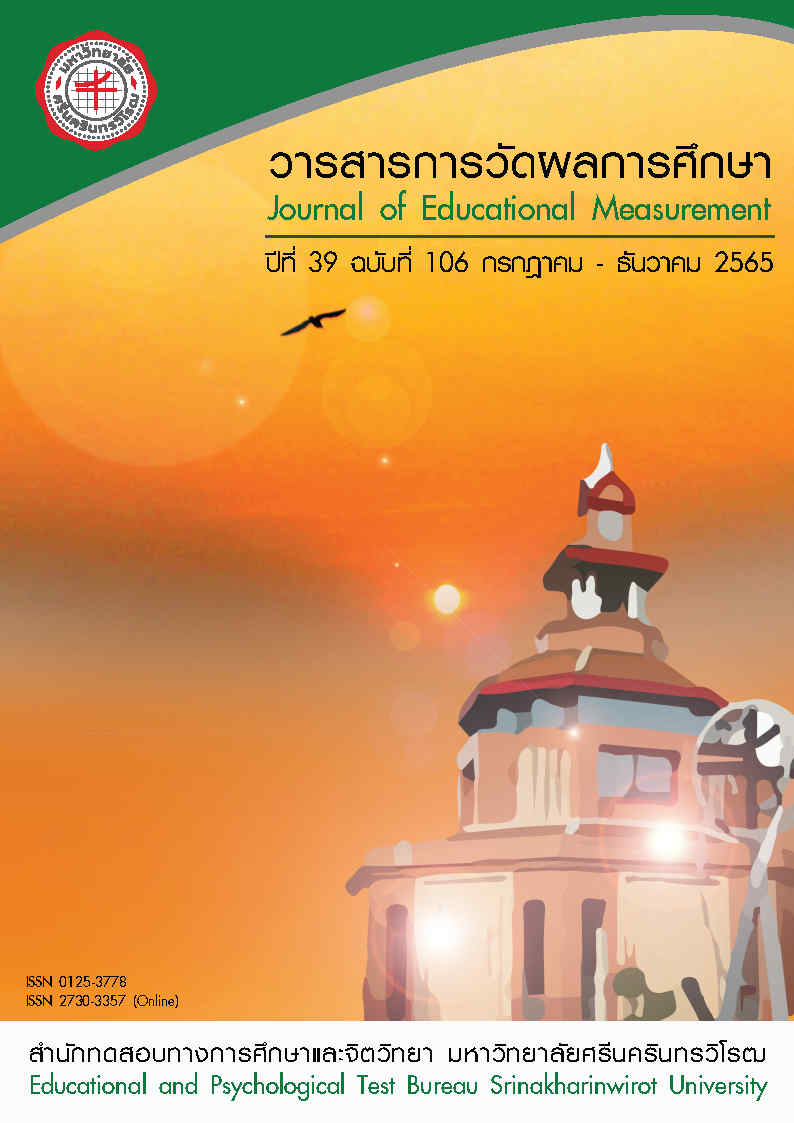การวิเคราะห์อภิมานงานวิจัยระดับบัณฑิตศึกษาเกี่ยวกับกลยุทธ์การสอนที่ใช้ในการพัฒนาทักษะภาษาอังกฤษของนักเรียนไทย
คำสำคัญ:
การวิเคราะห์อภิมาน, งานวิจัยระดับบัณฑิตศึกษา, กลยุทธ์การสอน, ทักษะภาษาอังกฤษ, นักเรียนไทยบทคัดย่อ
การวิจัยนี้เป็นการวิจัยเชิงปริมาณ มีวัตถุประสงค์เพื่อ 1) วิเคราะห์ลักษณะงานวิจัยระดับบัณฑิตศึกษาเกี่ยวกับกลยุทธ์การสอนที่ใช้ในการพัฒนาทักษะภาษาอังกฤษของนักเรียนไทย 2) ประเมินคุณภาพของงานวิจัยระดับบัณฑิตศึกษา และ 3) เปรียบเทียบลักษณะงานวิจัยระดับบัณฑิตศึกษากับดัชนีมาตรฐาน ตัวอย่างการวิจัยคือวิทยานิพนธ์ในมหาวิทยาลัยของรัฐแห่งหนึ่งที่ศึกษาโดยใช้รูปแบบการวิจัยเชิงทดลองตีพิมพ์ภาษาอังกฤษ และตีพิมพ์ในปี 2547-2563 จำนวน 22 ฉบับ เครื่องมือที่ใช้ในการวิจัย ได้แก่ แบบบันทึกข้อมูลและแบบประเมินคุณภาพงานวิจัย วิเคราะห์ข้อมูลโดยใช้สถิติ t-test และ one-way ANOVA ผลการวิจัยพบว่า งานวิจัยระดับบัณฑิตศึกษาส่วนใหญ่เน้นศึกษาเกี่ยวกับคำศัพท์เป็นหลัก (31.81%) กลยุทธ์การสอนที่ใช้มากที่สุดคือสื่อการสอน (72.72%) ตัวอย่างวิจัยส่วนใหญ่ศึกษากลุ่มนักเรียนระดับมัธยมศึกษา (63.63%) งานวิจัยระดับบัณฑิตศึกษาจำนวน 18 เรื่อง มีคะแนนรวมอยู่ในระดับที่สูงมาก และจำนวน 4 เรื่องมีคะแนนรวมในระดับสูง การเปรียบเทียบลักษณะงานวิจัยระดับบัณฑิตกับดัชนีมาตรฐาน พบว่า ตัวแปรด้านขนาดตัวอย่างมีความแตกต่างอย่างมีนัยสำคัญที่ระดับ .05 ส่วนเทคนิคการสุ่มตัวอย่างมีความแตกต่างอย่างมีนัยสำคัญทางสถิติที่ .01 ดังนั้นความแตกต่างของตัวแปรเหล่านี้จึงส่งผลต่อความแตกต่างของผลสัมฤทธิ์ทางการเรียนของนักเรียน การวิเคราะห์อภิมาน พบว่า ตัวแปรขนาดกลุ่มตัวอย่างที่มีค่าเฉลี่ยขนาดอิทธิพลสูงที่สุดคือ กลุ่มนักเรียน 30-39 คน โดยมีค่าเฉลี่ยขนาดอิทธิพล 3.23 ดังนั้นการสอนในห้องเรียนที่มีนักเรียน 30-39 คน จะส่งผลให้ผลสัมฤทธิ์ทางการเรียนดีกว่าห้องขนาดอื่น ๆ สำหรับเทคนิคการสุ่มตัวอย่างที่มีค่าเฉลี่ยของขนาดอิทธิพลสูงที่สุด คือ การสุ่มตัวอย่างแบบสะดวก รองลงมาคือ การสุ่มตัวอย่างอย่างง่าย และ การสุ่มตัวอย่างแบบเจาะจง โดยมีค่าเท่ากับ 3.02 1.39 และ 1.33 ตามลำดับ
เอกสารอ้างอิง
Byrne, B. M. (2010). Structural equation modeling with AMOS: Basic concepts, applications, and programming. Routledge.
Dijkstra, S. (2004). The integration of curriculum design, instructional design and media choice. In N. M. Seel & Dijkstra, S. (Eds.). Curriculum, plans and Processes in Instructional Design. (pp.131-144). Mahwah, Lawrence Erlbaum Associates, Publishers.
Educational Testing Service. (2011). Sending your scores. In GRE general test. http://www.ets.org/gre/general/scores/send
EF English Proficiency Index. (2019). The world’s largest ranking of countries and regions by English skills.https://www.ef.edu/epi.
Glass, G. V., McGaw, B., & Smith, M. L. (1981). Meta-analysis in social research. Sage.
Greene, J. P. (1998). A meta-analysis of the effectiveness of bilingual education.The public policy clinic of the Department of Government, University of Texas at Austin, The Program on Education Policy and Governance at Harvard University.
Hair, J. F., Black, W. C., Babin, B. J. & Anderson, R.E. (2010). Multivariate data analysis (7th Ed). Pearson.
Hair, J. F., Hult, G. T. M., Ringle, C. M., & Sarstedt, M. (2014). A Primer on Partial Least Squares Structural Equation Modeling (PLS-SEM). Sage.
Huttner-Koros, A. (August 21, 2015). The hidden bias of science’s universal language. https://www.theatlantic.com/author/adam-huttner-koros/
Issac, J. C. (2010). Methods and strategies of teaching: An overview. Pondicherry University Press.
Imsa-ard, P. (2020a). Motivation and Attitudes towards English Language Learning in Thailand: A Large-Scale Survey of Secondary School Students. rEFLections, 27(2), 40-61.
Imsa-ard, P. (2020b). Voices from Thai EFL teachers: Perceptions and beliefs towards the English test in the national examination in Thailand. LEARN Journal. 13(2). 269-287.
Khamanee, T. (2013). Teaching style: a variety of options (8th Ed). Chulalongkorn University.
Khaneeyor, K. (2017). The effectiveness of authentic listening materials on EFL primary students’vocabulary learning (Unpublished master’s thesis).Srinakharinwirot University, Bangkok.
Khankhaeng, P. (2021). Synthesis of research on innovations of learning process management for developing learning achievement in English subjects of secondary school students (Unpublished master’s thesis). Sakon Nakhon Rajabhat University, Sakon Nakhon.
Natawetch, P. (2020).The study on the use of flipped classroom strategy to develop grammatical accuracy in writing and the students' perception towards flipped classroom(Unpublished master’s thesis). Srinakharinwirot University, Bangkok.
Noom-ura, S. (2013). English-Teaching problems in Thailand and Thai teachers’ professional development needs English Language Teaching, 6(11), 139-147. https://doi:10.5539/elt.v6n11p139
Pipatsathidkul, P. (2013). A research synthesis of innovations for developing analytical thinking skills in Thai subject of basic education students (Unpublished master’s thesis). Srinakharinwirot University, Bangkok.
Shelby, L. B., & Vaske, J. J. (2008). Understanding meta-analysis: A review of the methodological literature. Leisure Sciences, 30(2), 96–110.https://doi:10.1080/01490400701881366
Sirithararatn, N. (2007). A development of the English oral communication course using the project-based learning approach to enhance English oral communication ability of Kasetsart University students [Unpublished doctoral dissertation]. Chulalongkorn University.
Smith, M. L., & Glass, G. V. (1977). Meta-analysis of psychotherapy outcome studies. American Psychologist, 32(9), 752–760. https://doi.org/10.1037/0003-066X.32.9.752
Sriha, K. (2020). Using movies in developing Thai students’ pronunciation of English final sounds (Unpublished master’s thesis). Srinakharinwirot University, Bangkok.
Teansriratchagul, W., Pattanasith, S.,& Srifa, P. (2022). The development of vocabulary bingo game with augmented reality technology ofenglish subject of mattayomsuksa 2 at Promburiratchadapisek school Journal of Educational Measurement.39(105). 99-111.
Thupatemee, K., & Kunarak, P. (2022). A Study of English Language Teaching, Policy Implementation and Guidelines for Aligning English Teaching in Secondary School with the Common European Framework of Reference for Languages Journal of Educational Measurement.39(105). 161-174.
Willig, A. C. (1985). A meta-analysis of selected studies on the effectiveness of bilingual education. Review of Educational Research, 55(3), 269-317.
Wiratchai, N. (1999). Meta-Analysis.Chulalongkorn University.



